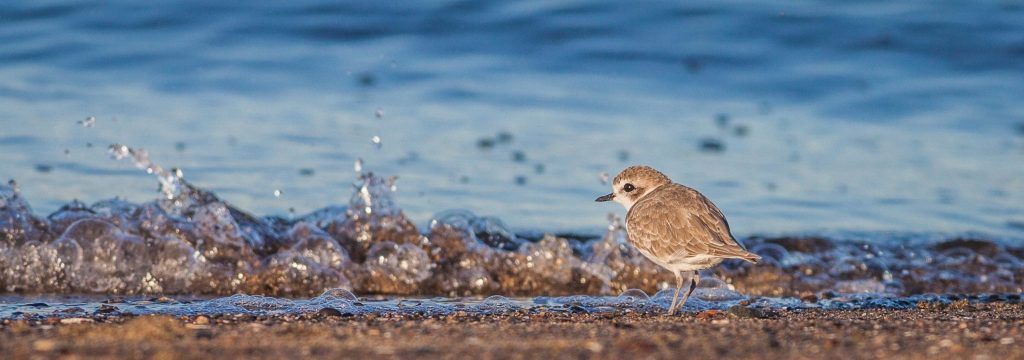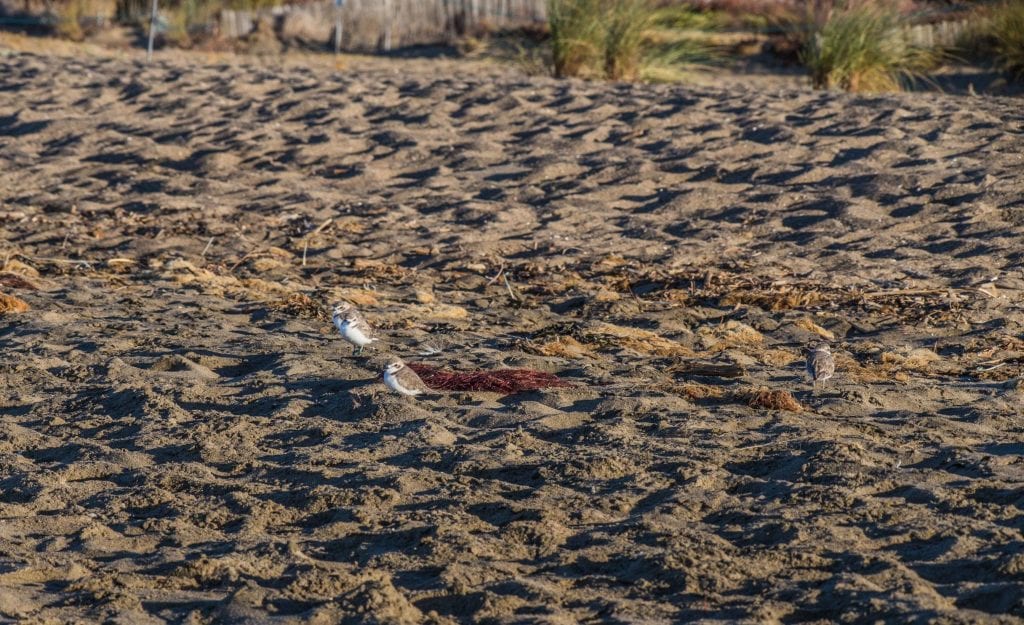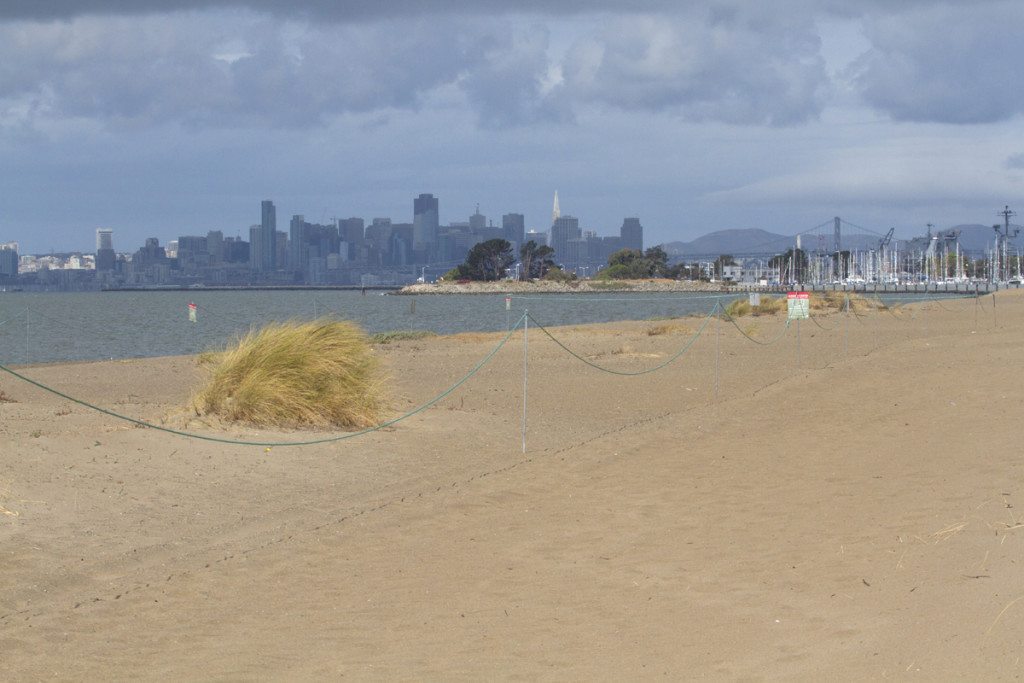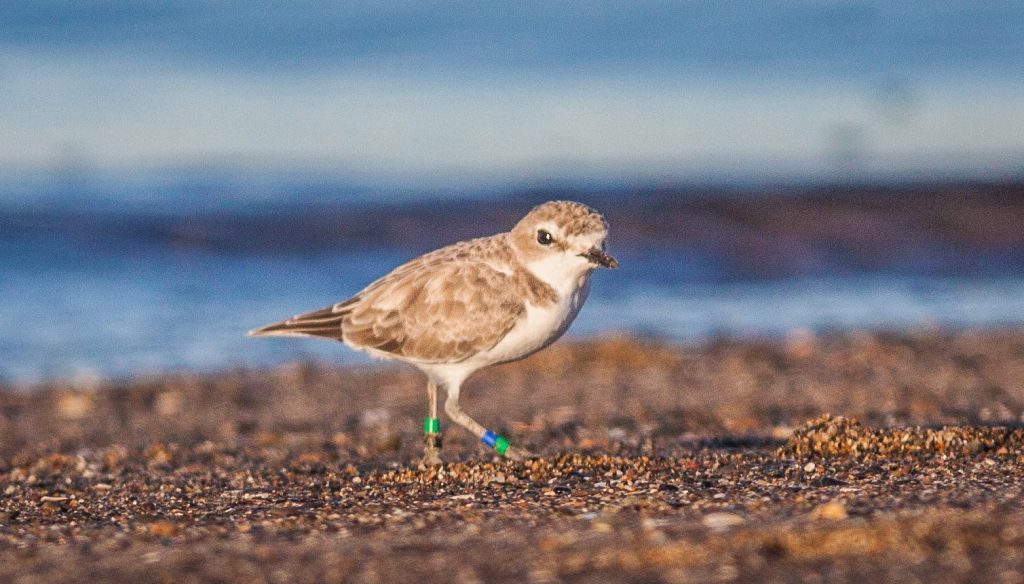Snowy Plovers are back… with some human help
By Ilana DeBare
One of our favorite shorebirds is back for the winter… and in Alameda, at least, they are finding a safer roosting site than in the past thanks to teamwork by Golden Gate Bird Alliance and the East Bay Regional Park District.
Western Snowy Plovers are tiny shorebirds (just 1.2 to 2 ounces) that winter on many Bay Area beaches. The smallest birds in the plover family, most migrate inland for summer breeding, although a small number also breed here.
There are only an estimated 2,500 Snowy Plovers on the Pacific Coast; the federal government listed the western population as threatened in 1993. One of the challenges they face is that the flat sandy beaches where they roost have been overtaken by development and human recreation. It can be almost impossible for plovers to roost on urban shorelines without being flushed by off-leash dogs or joggers.
Why are secure roosting sites important? Casual passersby often think, “What’s the big deal? If a dog chases them, they can fly up and then settle right back down.”

But roosting is in fact an essential activity for shorebirds like plovers. Their breeding cycle is intensive and exhausting: Snowy Plovers are polyamorous, and the female may mate with several males and lay up to three clutches of eggs in three different locations a single season. She leaves after the eggs hatch, and then the male takes on sole responsibility for tending the young.
“You can imagine that’s a pretty intensive expenditure of energy by both the females and the males,” says Cindy Margulis, Executive Director of Golden Gate Bird Alliance. “They have this flurry of breeding activity, then they have to rest and begin to rebuild their energy stores during the winter. That’s where the problem with roost sites occurs.”

When you have busy beaches with scores of dogs and hundreds of pedestrians flushing birds over and over throughout the day, it’s impossible for them to rest. Some of the disturbance is unintentional: Plovers, which roost in shallow indentations in the sand, blend in so well that beachgoers often don’t notice them until they practically step on them.
This is where people can help – and in the case of the Alameda plovers, have helped.
Two years ago, GGBA members doing a shorebird survey noticed roosting plovers on Alameda’s Crown Beach. These individual birders approached the East Bay Regional Park District and asked for protection of the tiny birds. GGBA offered guidance and advice.
Last winter, the District erected educational signage and a symbolic cord fence around the plovers’ preferred roosting area – just a small section of the long beach, but enough to provide them with a safe rest zone.
This fall, returning plovers were spotted by GGBA members in the last week of August, fully three weeks earlier than in 2014. GGBA notified the Park District immediately and within 48 hours, the District reinstalled the signage and symbolic fencing for the winter! Over the past few weeks, about seven plovers have been documented roosting in the protected area – including one banded bird that had spent its crucial first winter at Crown Beach, after being hatched at Ravenswood Slough in Palo Alto in June 2014.



We applaud East Bay Regional Parks for their responsiveness to the plovers. We’re sure that Alameda beachgoers also appreciate it – both the protection of the birds and the opportunity to learn about an adorable, threatened species in their own backyard. GGBA volunteers often let beachgoers view the birds through their scopes, and people fall in love with these tiny creatures.
We wish that other shoreline managers would take similar protective measures. At Ocean Beach in San Francisco, a flock of 95 Snowy Plovers was spotted earlier this month – a much bigger group than is typically found there! Ocean Beach has signs about the plovers in a designated section of the beach, but there is no symbolic fencing, a best-practice recommendation by the U.S. Fish & Wildlife Service for Western Snowy Plovers. And off-leash dogs are an almost constant presence on Ocean Beach, frightening and flushing birds.
“We need more visible protection for plovers roosting on Ocean Beach,” said Margulis. “We also need stronger enforcement of existing rules that require dogs to be on leash — although it would be even better for shorebirds if, like at Crown Beach, dogs were not allowed there at all.
“Ocean Beach is valuable habitat. There’s room for both humans and birds to be there. All it takes is being a little more thoughtful and considerate.”
—————————
Golden Gate Bird Alliance has worked for years to protect Snowy Plovers on Ocean Beach and Crissy Field in San Francisco, as well as in Alameda. Our volunteers track the S.F. population and have presented documentation to park managers about off-leash dog disturbances. GGBA also holds a volunteer beach clean-up of plover habitat at Crissy Field on the second Monday of each month, from 10 a.m. until noon. Join us! For volunteer details, see https://goldengatebirdalliance.org/volunteer/.
